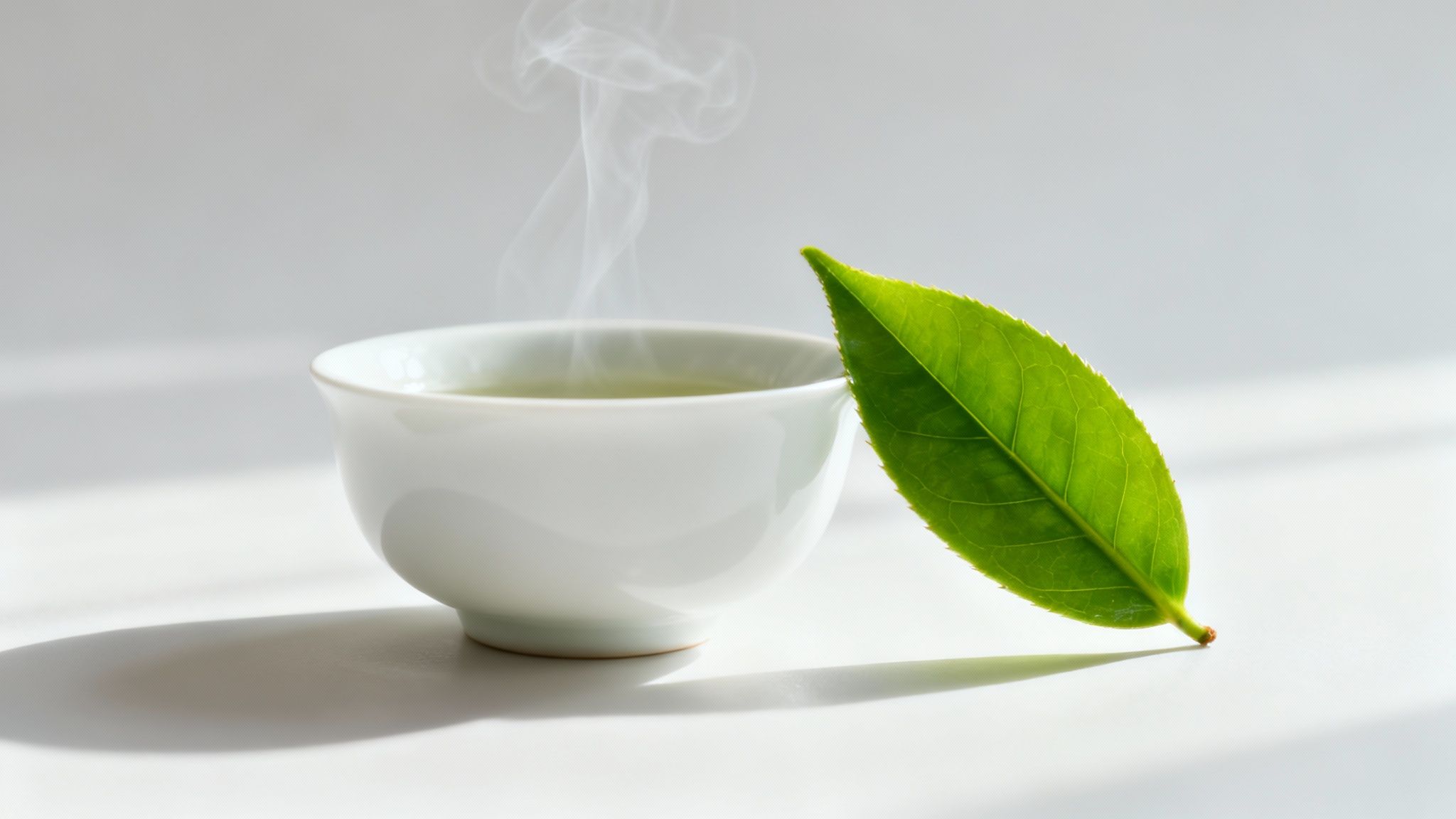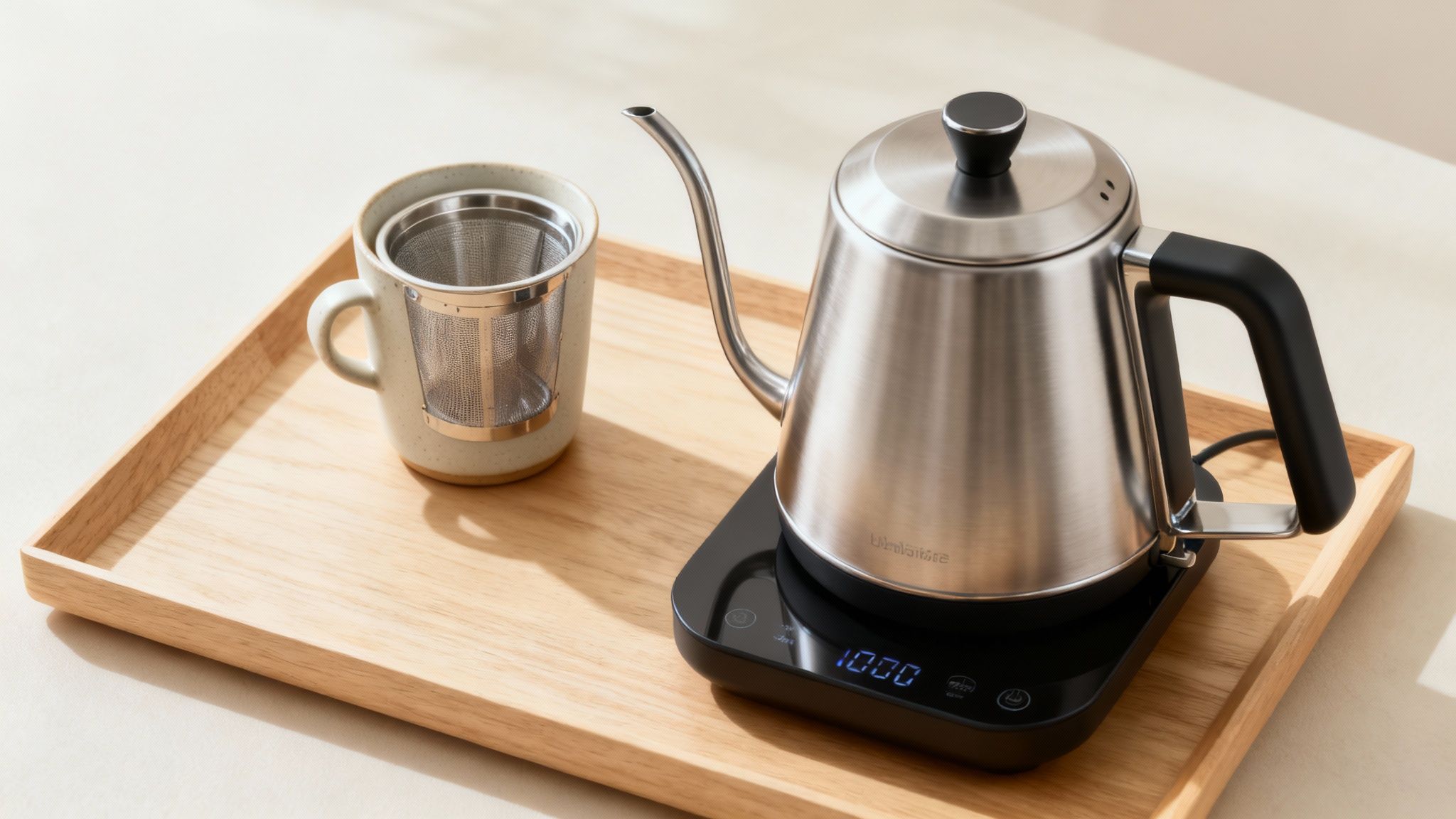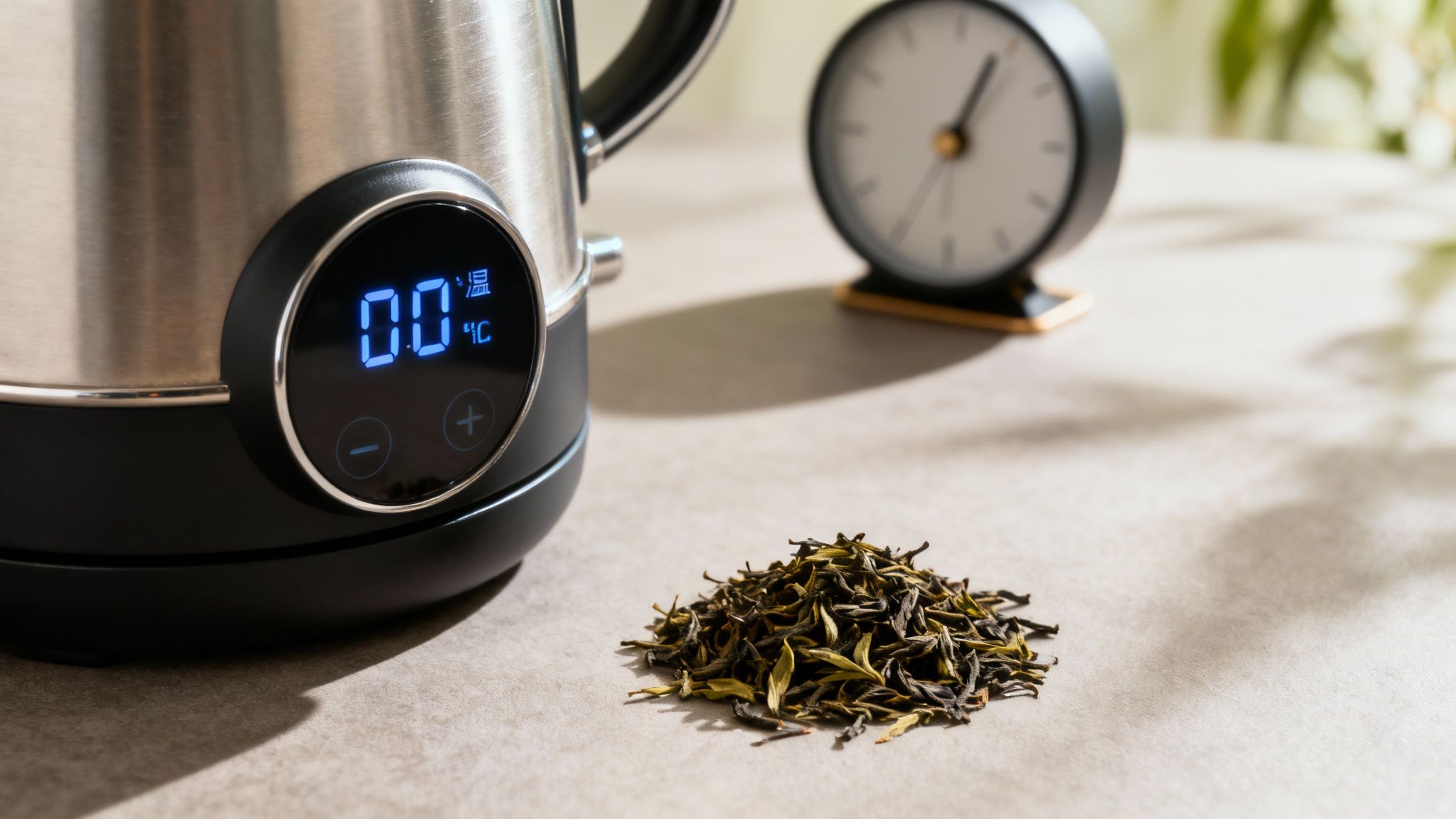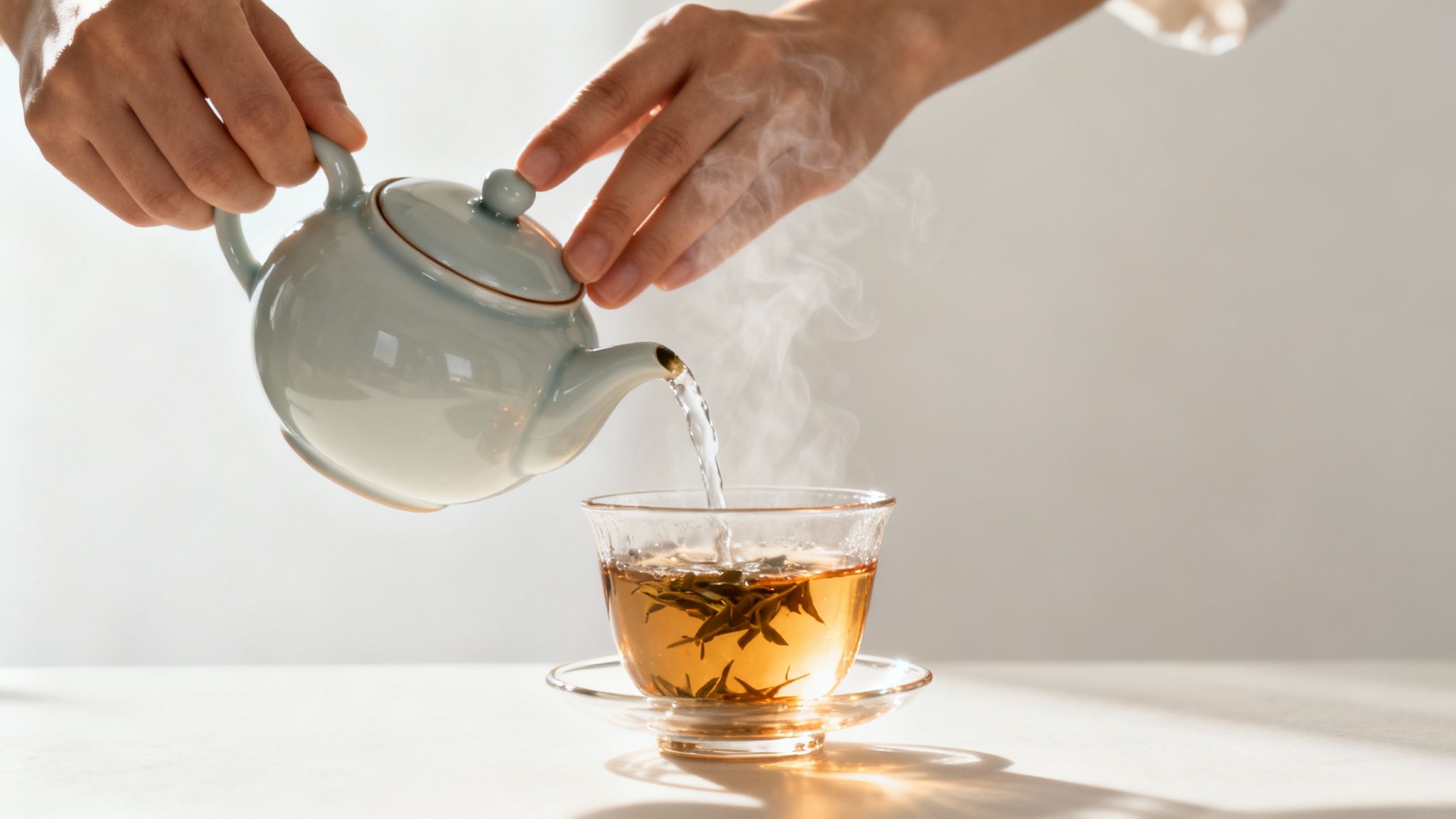Making the leap from tea bags to loose leaf is simpler than you might think. It really just boils down to a few key things: getting your leaf-to-water ratio right, heating your water to the perfect temperature, and letting it steep for just the right amount of time. The magic happens because whole leaves have the space they need to unfurl and release their full, nuanced flavour – something you just don't get from a cramped tea bag.
From Simple Leaf to Perfect Cup

Welcome to the wonderful world of loose leaf tea. This is where a simple daily cuppa transforms into a genuine sensory experience. If your tea journey so far has been limited to bags, prepare for a serious upgrade in both flavour and aroma. Trust me, it’s nowhere near as intimidating as it sounds, and you certainly don't need to be an expert to brew an exceptional cup.
This guide is here to demystify the whole process and prove that anyone can master the art of making loose leaf tea. We'll walk through the core principles that will have you brewing a delicious cup, every single time. It's time to forget the dusty fragments found in most commercial bags and focus on the character you can only get from whole leaves.
Why Choose Loose Leaf?
Honestly, the difference between loose leaf and bagged tea is like night and day. It all comes down to quality and space. As whole leaves steep, they have room to expand and release their essential oils and complex flavours – something the finely chopped tea dust in bags just can't do.
The advantages are pretty clear:
- Superior Flavour: You get fuller, more intricate taste profiles that are simply on another level.
- Greater Freshness: The leaves are often higher quality, which means a much better aroma.
- Cost-Effective: Good quality leaves can often be re-steeped multiple times, giving you more bang for your buck.
The British are famous for their tea habit, consuming over 100 million cups daily. Interestingly, the standard tea bag holds about 2-3 grams of tea, which just so happens to be the ideal measure for a single cup of loose leaf—roughly one rounded teaspoon.
Embracing this method also connects you more deeply to what you're drinking. There's something wonderfully mindful about the ritual of measuring the leaves and watching them infuse. Plus, there are plenty of wellness advantages to this style of brewing. You can learn more by exploring the many loose leaf tea benefits in our detailed article.
Choosing Your Tea Brewing Essentials

You really don't need a counter overflowing with gear to make a truly exceptional cup of tea. It's more about having a few key pieces that work for you. Let's start with the absolute foundation of any good brew: the water.
It might sound fussy, but the quality of your water makes a world of difference to the final flavour. Tap water, especially in hard water areas, is often full of minerals and chlorine that can easily overpower the delicate notes in your tea leaves. If you've ever found your tea tasting a bit flat or metallic, this is probably why. A simple domestic water filter can be a brilliant investment, stripping out those impurities and letting the tea's true character shine through.
Next up, a good kettle. While any kettle can boil water, a variable temperature model is a genuine game-changer for any serious tea drinker. It gives you precise control, which is crucial because dumping boiling water on delicate green or white teas is a fast track to a bitter, disappointing cup.
Finding the Right Infuser
Once you have your perfectly heated water, you need something to steep your leaves in. This is where an infuser comes in, and you’ve got a few great options. The goal is always the same: give the leaves plenty of room to unfurl and release all their wonderful flavour.
- Basket Infusers: My personal favourite for a single mug. They sit right in your cup and give the leaves maximum space to swim around.
- Teapots with Built-in Strainers: A classic for a reason. They’re ideal when you're making tea for two (or more) and are incredibly easy to use and clean.
- Gaiwan: If you fancy a more traditional, mindful brewing experience, a gaiwan is fantastic. This simple lidded bowl is perfect for multiple short infusions, especially with oolongs.
The single most important thing to look for is space. Those small, novelty-shaped tea balls might look cute, but they cramp the leaves, which means you're not getting the full flavour. Always pick an infuser that gives your tea room to breathe.
Finally, don't underestimate the power of a good mug! The right vessel just makes the whole experience better. Some of the most practical designs are the all-in-one infuser tea cups, which come with their own basket infuser and a lid to keep your tea perfectly hot while it brews. Simple, but so effective.
Getting the Temperature and Timing Just Right

The real magic behind a perfect cup of tea isn't some complex secret—it's all about getting the balance of leaf, water, and time right. This is where a little bit of science can transform your daily brew.
A brilliant place to start is with the golden ratio: try using one rounded teaspoon (that's about 2-3 grams) of tea for every 240ml of water. Think of this as your baseline. From here, you can tweak it until it’s perfect for you.
Getting this balance right is what unlocks those incredible, nuanced flavours. It’s no wonder, really; in a UK market valued at over US$2.55 billion, where proper loose leaf tea accounts for roughly 30% of sales, the brewing method is what separates a good cup from a truly memorable one.
Why Temperature Makes All the Difference
One of the most common mistakes I see is people pouring boiling water over every kind of tea. It's an easy habit to fall into, but it’s a surefire way to ruin a delicate brew. Different teas need different temperatures to release their best qualities without becoming bitter.
For example, a robust black tea needs that near-boiling heat to bring out its deep, malty character. But if you hit a delicate Japanese Sencha with that same temperature? You’ll scorch the leaves, leaving you with a harsh, astringent taste instead of its lovely grassy sweetness.
Think of it like cooking. You wouldn't blast a delicate piece of fish with the same high heat you'd use for a jacket potato. Tea leaves are just as sensitive.
A Quick Guide To Tea Brewing Temperatures and Times
Here's a handy little table to get you started on the right track. Remember, these are guidelines—the best part of brewing loose leaf tea is experimenting to find what you love.
| Tea Type | Water Temperature (°C) | Steep Time (Minutes) | Flavour Profile Notes |
|---|---|---|---|
| Black Tea | 90-100°C | 3-5 | Bold, brisk, and malty. Stands up well to milk and sugar. |
| Green Tea | 75-85°C | 1-3 | Grassy, vegetal, and sometimes nutty or sweet. Watch the time! |
| White Tea | 70-80°C | 2-4 | Incredibly delicate, floral, and subtly sweet. Very sensitive to heat. |
| Oolong Tea | 85-95°C | 2-5 | A huge range, from light and floral to dark and roasted. |
| Herbal Infusion | 100°C | 5-7+ | Bright and flavourful. Can be fruity, spicy, or minty. |
Once you've got the hang of temperature and timing, you can start exploring other factors. For a deeper dive, our guide on https://www.jeevesandjericho.com/blogs/news/how-long-are-you-supposed-to-brew-tea has some fantastic extra tips.
And don't forget the water itself! The quality of your H₂O makes a massive difference. If you're using hard tap water, you might be masking some of the tea's best notes. It's well worth looking into optimizing water quality for your brew by using a simple filter; you'll be amazed at the improvement.
Creating Your Daily Brewing Ritual

Right, let’s put all that theory into practice. The aim isn't to follow a strict set of rules, but to find a simple, repeatable rhythm that becomes a mindful pause in your day. Think of it less as a chore and more as a small act of self-care.
First things first: warm your brewing vessel. A quick swirl of hot water in your teapot or mug before you begin makes a world of difference. Tip it out, and you’re ready. This tiny step stops the cold ceramic from stealing heat, keeping your brewing temperature right where you want it.
Now, for the leaves. Grab your teaspoon or scales and measure out your chosen amount of tea into your infuser. Pop the infuser into your pre-warmed pot or mug, and you're all set for the main event.
The Infusion Process
Carefully pour your heated water over the leaves, making sure they’re all completely submerged. This next part is crucial: start your timer immediately. Honestly, this is the single biggest key to avoiding a bitter or disappointingly weak brew. Don't just guess it.
As soon as that timer pings, lift the infuser out. It's a common mistake to leave the leaves stewing in the water, but this leads to over-extraction – the culprit behind that unpleasant, astringent bitterness we all want to avoid.
One of the great joys of brewing loose leaf tea is the ability to re-steep. High-quality leaves, particularly Oolongs and green teas, are designed for multiple infusions, with each steep revealing new layers of flavour and aroma.
The Art of the Re-Steep
Don’t you dare throw those leaves away! Many premium teas will happily give you a second, third, or even fourth beautiful cup from the same serving.
For subsequent infusions, try increasing the steep time or the water temperature just a touch to coax out the remaining character. It’s a brilliant way to explore the full journey of the leaf, and it makes your tea far more economical. Win-win.
Are You Making These Common Brewing Mistakes?
Even the most seasoned tea drinkers can fall into a few simple traps that ruin an otherwise perfect cup. Pinpointing these common slip-ups is the quickest way to level up your brewing game, ensuring every mug is balanced and full of flavour.
The number one culprit? Using water that’s far too hot. Pouring boiling water straight from the kettle onto delicate green or white teas literally scalds the leaves. This forces out bitter-tasting tannins, leaving you with an unpleasant, astringent brew.
Over-steeping is another classic flavour-killer. Leaving the leaves in for too long doesn't make the tea stronger, it just makes it bitter. This is where a timer becomes your best friend.
Finally, getting the leaf-to-water ratio wrong is an easy mistake to make. Too few leaves and you’ll have a weak, watery disappointment. Too many, and it's just overpowering and wasteful. As a starting point, stick to the general rule of one teaspoon per cup.
A Few Pro Tips to Elevate Your Brew
Once you’ve got the basics down, a few small tweaks to your daily ritual can make all the difference. These are the little habits that separate a good cup of tea from a truly exceptional one.
- Filter Your Water: If you're in a hard water area, the minerals in your tap water can really dull the taste of your tea. Using filtered water is a simple switch that lets the tea's true, complex flavour profile shine.
- Give Certain Teas a Rinse: For aged teas like Pu-erh or some Oolongs, it's worth giving them a quick 5-10 second rinse with hot water. This "wakes up" the leaves, washes away any dust, and gets them ready for the main infusion.
- Store It Properly: Your tea’s biggest enemies are oxygen, light, and moisture. To keep those delicate aromas and flavours intact for as long as possible, store your leaves in an opaque, airtight container tucked away in a cool, dark cupboard.
While tea bags are still king in the UK, the shift to loose leaf is undeniable. It's fascinating that while 84% of UK drinkers stick with bags for their black tea, this changes with age. A significant 27% of those aged 30-44 are now choosing loose leaf, showing a clear trend towards quality brewing. You can read more in the UK Tea & Infusions Association's census.
A Few Final Questions
Even once you've got the basics down, a few questions always seem to pop up when you're getting into loose leaf tea. Let's tackle some of the most common ones to help you perfect your daily ritual.
Can I Reuse Loose Leaf Tea Leaves?
Yes, absolutely! This is one of the great joys of drinking good quality tea. Most whole-leaf teas, particularly Oolongs and many greens, are made to be infused more than once.
With each new steep, you’ll often discover different, more subtle notes that weren’t there in the first cup. Just add a little extra time or nudge the water temperature up for your second or third infusion to draw out those hidden flavours. The only real exception is herbal infusions – they tend to give up all their goodness in one go.
Re-steeping is one of the best things about switching to loose leaf. It’s not just better value for money than single-use tea bags; it also offers a far more complex, evolving tasting experience.
How Should I Store My Loose Leaf Tea?
To keep your tea fresh and tasting its best, you need to protect it from its four enemies: heat, light, air, and strong smells. The best way to do this is with an opaque, airtight container – a proper tea caddy is ideal.
Find a cool, dark spot for it, like a kitchen cupboard, but make sure it’s far away from any pungent spices or your bag of coffee. Whatever you do, don't put it in the fridge! The condensation can quickly ruin the delicate leaves.


